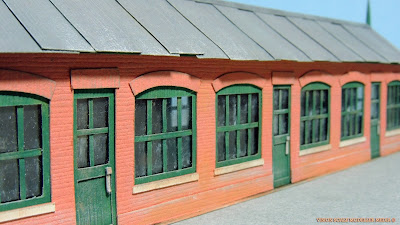I was looking around my Father's supply of wood and tools from the garage, and I noticed there were a few Duran paint sticks. I though these could make long walls to divide the yard from the scenery. I'll share with its construction, which took about thirty minutes to make.
- I cut several strips of balsa wood to make the raised dividers, and had them glued to the Duran stick.
- Next I cut long strips of my textured card-stock to the stick's height, and glued it to the wall.
- I mixed acrylics to make various brick colors to paint on the paper, and then weathered it using lighter colors.
- A long strip of balsa was cut and glued on the edge, for the wall's trim on top, and glued a long card strip to texture it.
- Finally, squares of card were glued on the trim for the wall's caps.
Sometimes there are wires that run along walls to power yard equipment, from signals to lights. For a finishing touch, I added wire that was painted and bent using pliers to fit snug onto the dividers, and glued rolled paper to add fasteners. The generator was a spare part I found and painted, then it was taped to the wall so I could take it off and use it for something else if I wanted to.
You can get an idea how it looks as a great compositional element in this photo. With the balsa dividers, the Duran stick stood well upright by itself. If I made more for a diorama, they can be braced, glued along hills and textured, maybe a few doors and gates for people and vehicles. Maybe there could be a gate made with a metal decorative arch, over iron doors, which say Tidmoth!
So if I make a batch of these glued in different lengths, they will look nice used for Knapford Yards, Wellsworth or the Harbor. This method of using sticks could also be used to make the brick facade on docks.
Placed flat, these can be made into low, freight loading platforms for wagons in the sidings, warehouses, or transfer yards.



















